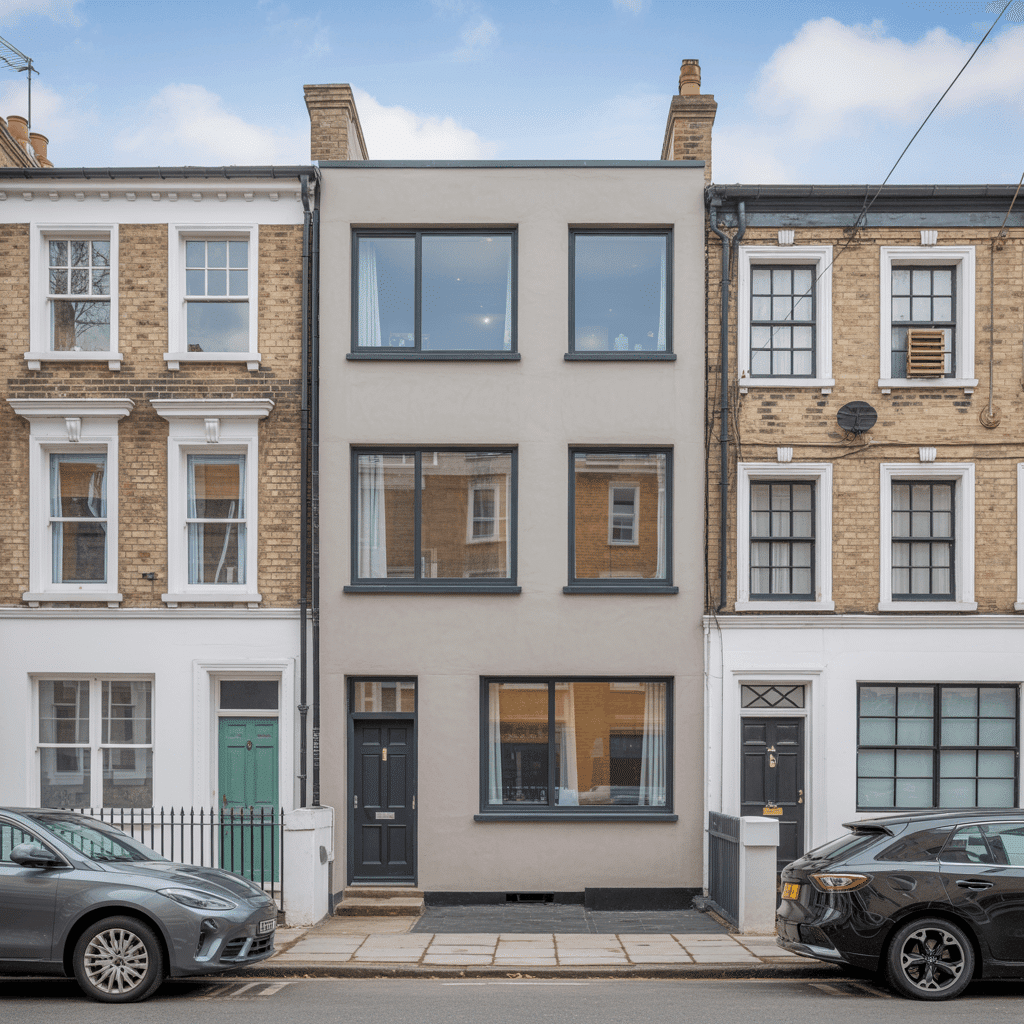The Great Thermal Dilemma
Why heritage homeowners must now choose — upgrade or replace
Period homes carry a quiet elegance. Their proportions, detailing, and craftsmanship speak of an architectural language long lost in contemporary construction. But behind the beauty lies a recurring frustration: persistent cold, rising energy bills, and windows that allow heat to escape as readily as they let in the morning light.
For years, this has been accepted as the cost of character.
You’ve been told that heritage windows must “breathe.” Those conservation rules limit your options. That comfort and authenticity cannot coexist.
Yet this narrative no longer holds.
Rising energy prices, stricter carbon reduction targets, and increasingly unforgiving EPC requirements are reshaping how owners of older properties approach their building fabric. No element is under more scrutiny — or delivers more measurable inefficiency — than the glazing.
The key performance metric is no longer anecdotal, nor aesthetic. It’s U-value. A single number that quantifies how much heat escapes through your windows. A number that now translates directly into energy spend, regulatory compliance, and long-term comfort.
Low U-values retain heat. High U-values lose it. And the difference between the two is no longer a marginal issue — it’s a material liability.
This is the moment many heritage homeowners must confront: whether to preserve existing frames and attempt minor gains, or invest in full replacement with systems that maintain architectural fidelity while dramatically improving thermal performance.
The decision is no longer a matter of style. It’s one of value, efficiency, and longevity.
What U‑Values Really Mean (And Why They Matter)
The quiet numbers driving your heating bill
At the heart of every window performance claim sits a single number: the U‑value. It’s measured in watts per square metre per kelvin (W/m²K). The lower the U‑value, the less heat your home loses. The higher the U‑value, the more your boiler works to replace what leaks away.
For decades, homeowners ignored this metric. It lived in architects’ specifications and building control reports, not in the language of daily life. But energy prices, carbon targets and tighter regulations have changed that. U‑values now directly influence your EPC rating, your running costs, and your resale value.
To put the scale in perspective:
- Single glazing in many period properties scores around 5.0 W/m²K.
- Basic secondary glazing may lower this to 2.5–3.0 W/m²K.
- Heritage‑style double glazing achieves roughly 1.4–1.6 W/m²K.
- Thermally broken aluminium or composite frames can reach 0.8–1.2 W/m²K, a figure once reserved for new‑build Passive House projects.
Those aren’t marginal gains. They’re leaps in efficiency. And because heat loss through windows can account for up to 30% of a home’s energy consumption, every decimal point you shave off your U‑value has a measurable impact on your comfort and your bill.
This is why U‑values aren’t just a regulatory footnote. They’re the hidden ROI driver behind every decision you make about your windows. In the next section, we’ll look at whether retrofitting your existing frames can deliver enough of that return — or if full replacement is the only way to reach modern performance.
Retrofit Solutions — Quick Fix or False Economy?

Secondary glazing, draught-proofing, slimline units: what really works?
Retrofit is the comforting middle ground. It promises warmth without disruption. Familiarity without sacrifice. For homeowners wary of disturbing the architectural rhythm of their property, it seems the obvious route: less mess, lower cost, heritage intact.
The logic is understandable. Retrofitting options like secondary glazing, magnetic panels, slimline double-glazed units, and draught-proofing are marketed as low-impact alternatives to full window replacement. And in some cases, they do offer modest improvements. You might see U-values improve from 5.0 W/m²K to 2.5–3.0 W/m²K. That can take the edge off a cold room, reduce condensation, and marginally lower your energy bills.
But there’s a caveat. Retrofit solutions rarely offer structural thermal integrity. They operate as surface-level treatments on a system that was never designed to insulate. Gaps remain. Cold bridges persist. And materials age quickly under repeated thermal stress. What begins as a ‘solution’ often becomes a stopgap.
The aesthetic compromises can be subtle but frustrating. Condensation between panes. Unflattering reflections. Panels that rattle in high winds or detach over time. And slimline units — while visually sympathetic — often struggle to match the thermal performance of modern double or triple-glazing systems engineered from the ground up.
Then there’s the long game. Retrofit systems typically come with shorter warranties, less durable seals, and a lower impact on your home’s EPC rating — meaning limited gains in resale value or long-term energy savings.
This isn’t to say retrofitting is worthless. In certain listed buildings where full replacement is prohibited, it may be the only option. But for most homeowners outside strict conservation constraints, retrofit is often less of a solution and more of a delay.
If you’re looking for measurable ROI, regulatory compliance, and lasting comfort, you’ll need to look beyond retrofit. And that leads us to full replacement, where the performance conversation becomes far more compelling.
Full Replacement — The Intelligent Upgrade
How modern sash systems outclass tradition—without betraying it
If retrofitting is a patch, full replacement is a transformation. And thanks to advances in design, engineering, and heritage replication, it no longer means compromising the appearance of your period home.
Today’s best replacement systems — particularly those using thermally broken aluminium, aluclad, or composite materials — are purpose-built to deliver passive-grade performance without sacrificing architectural fidelity. They replicate the proportions, mouldings, sightlines, and finishes of traditional sash and casement windows with such precision that even planning officers are often hard-pressed to tell the difference.
But inside those beautifully crafted frames lies a very modern difference: U-values as low as 0.8–1.2 W/m²K. That’s the difference between rooms that hover at 16°C in winter and rooms that retain heat long after the boiler shuts off. It’s also the difference between a property that struggles to meet Part L regulations and one that exceeds them with confidence.
Beyond efficiency, full replacement offers something retrofit rarely can: longevity. Powder-coated aluminium, weather-sealed frames, and integrated triple glazing mean less maintenance, longer life, and higher resilience to the British climate. These aren’t short-term fixes — they’re multi-decade investments that future-proof both comfort and compliance.
What about aesthetics? That’s where Sash Windows London excels. Every replacement is handcrafted to mirror the original — not just in proportion, but in personality. Whether it’s a Georgian townhouse in Marylebone or a Victorian villa in Richmond, the visual harmony remains untouched. Only the performance changes.
And perhaps most importantly, full replacement clears the path to lower energy bills, better EPC ratings, and increased property value — making it not just a thermal upgrade, but a financial one.
The question is no longer whether replacement windows can look the part. It’s whether it makes sense to settle for anything less than a system that looks original — and performs like tomorrow.
The ROI Equation — What It Pays, When It Pays Off
A decade of bills vs a lifetime of warmth
At first glance, full window replacement looks expensive. It’s a capital outlay — a line item homeowners instinctively defer until “next year.” But dig beneath the sticker price, and a different story emerges — one where every frame becomes a financial instrument.
Let’s begin with the numbers.
A high-performance, thermally broken window system can reduce heat loss through glazing by up to 70% compared to single glazing, and around 40% compared to basic retrofit solutions. That translates to hundreds of pounds in energy savings per year — often £400 to £800, depending on the size and insulation profile of the home.
Now extend that over a 10-year horizon, and you’re looking at £4,000–£8,000 recouped—before factoring in escalating energy costs. Many systems pay for themselves within 6 to 9 years, with returns accelerating over time.
But energy isn’t the only vector of return. There’s maintenance. Aluminium-clad and composite frames require no repainting, no sanding, no regular resealing. Compared to the cyclical upkeep of timber windows (often £500–£1,000 per cycle), modern materials quietly save both time and money — year after year.
And then there’s property value. Homes with strong EPC ratings and low thermal leakage not only attract a premium, but also move faster in competitive markets. A new buyer doesn’t want a cold lounge or a boiler that runs nonstop. They want confidence. And confidence, in property, sells.
Lastly, there’s comfort ROI — harder to quantify, but impossible to ignore. Fewer cold spots. More consistent internal temperatures. A quieter, more peaceful home. These aren’t just nice-to-haves. They’re the foundations of everyday wellbeing.
So while retrofit might appear cheaper on day one, full replacement proves itself smarter by year five — and superior by year ten. It’s not just an improvement. It’s a capital upgrade that warms the house and strengthens the balance sheet.
And with Sash Windows London guiding the process, it’s executed with such heritage precision, your only regret will be waiting this long.
The Planning Puzzle — What You Can Actually Do

Navigating conservation areas, Part L, and Listed Building Consent
For many heritage homeowners, the biggest perceived barrier to window replacement isn’t cost — it’s permission.
The assumption goes something like this: “Because I live in a conservation area, or my building is listed, I can’t change my windows.” It’s a myth that’s taken hold over decades — and one that quietly costs homeowners thousands in lost efficiency every year.
The truth is more nuanced.
Yes, if your property is Grade II or higher, or situated in a conservation area, you will likely need to satisfy planning requirements before replacing original windows. But that doesn’t mean replacement is off the table. Far from it.
In fact, councils across the UK — including in sensitive London boroughs like Westminster, Kensington & Chelsea, and Camden — are now approving bespoke, heritage-matched replacements that maintain the external character while drastically improving thermal performance.
The key is detail. Sightlines. Mullion width. Beading. Handle placement. Paint finish. The more your replacement mirrors the original, the stronger the case for planning approval. And this is precisely where Sash Windows London excels.
Our in-house design team doesn’t just manufacture windows. It reverse-engineers the past. We liaise with conservation officers, architects, and planning consultants to ensure that every proposed upgrade passes not just building regulations, but heritage scrutiny. We even provide heritage statements, scaled CAD drawings, and photographic comparisons as part of the application package.
And if your home isn’t listed or within a conservation area? In most cases, no planning permission is required at all. You’re free to upgrade — and improve — with nothing more than standard building control compliance.
That includes:
- Meeting Part L (thermal efficiency)
- Retaining traditional appearance where needed
- Lifting your home’s EPC rating
Planning is not the barrier it’s made out to be. It’s a gateway — and with the right expertise, it’s one you can walk through with confidence.
The Sash Windows London Approach — Designed to Disappear
Why most people can’t tell we’ve replaced the windows — except for the warmth
When it comes to upgrading period windows, most homeowners fear one thing above all: losing the look.
The proportions. The weight. The timber grain. That elusive sense of architectural soul.
And yet — quietly, methodically — hundreds of heritage homes across London have undergone full thermal transformation without anyone noticing a visual change. No plastic shine. No awkward beading. No architectural betrayal. Just warmth where there was once cold.
That’s the Sash Windows London difference.
We specialise in windows that vanish into the original fabric of the home — not because they’re generic, but because they’re precisely designed to match what was already there. Every horn, bead, glazing bar, putty line, and paint finish is engineered to pass both human and heritage inspection.
But beneath that traditional surface lies something extraordinary.
Our systems are built around thermally broken aluminium cores, composite frames, and passive house-ready glazing. They achieve U-values as low as 0.8 W/m²K — unheard of in typical conservation work — all while satisfying the most demanding conservation officers.
It’s not just about product. It’s about process.
- We conduct on-site surveys with laser scanning accuracy.
- We work with listed-building consultants to navigate planning.
- We pre-finish frames in our own workshop to ensure consistency.
- And we install using methods that protect plasterwork, flooring, and internal finishes — with as little as one day of disruption per elevation.
The result? Clients who step into their newly upgraded homes expecting a visual change — and find none. Only quieter rooms. Even warmth. Lower bills. And, perhaps most surprisingly, compliments from neighbours who never noticed a thing.
This isn’t a compromise. It’s a craft. One we’ve perfected over decades, through the single-minded belief that heritage homes deserve to perform as well as they look.
The Final Frame — Choose Your Thermal Future
Make the upgrade that pays you back, feels better, and lasts longer
You didn’t buy your home to live with compromise. You chose it for its character, its history, its presence. And yet, day after day, it leaks comfort, energy, and money — all through the weakest link: your windows.
The truth is clear. Retrofit can only go so far. A stopgap. A partial win.
But full replacement — done with care, craft, and conservation in mind — offers something rare: a period home that feels like it belongs in the 21st century.
And when designed by experts who understand both heritage and performance, it’s no longer a question of trade-offs. It’s a win on every front:
- Lower energy bills
- Higher EPC ratings
- Stronger resale value
- Absolute aesthetic fidelity
- And most of all — everyday comfort, quietly delivered
At Sash Windows London, we don’t just replace windows. We restore integrity — thermal, architectural, and financial. We bring engineering and elegance into perfect alignment. And we do it with the kind of obsessive detail that makes planners nod and neighbours smile.
Now it’s your turn.
📞 Book your Design & Energy Consultation today — a no-obligation session where we’ll:
- Audit your current U-values
- Assess your eligibility for planning
- Match you with heritage-perfect replacements
- And give you the clarity to make the right decision for your home
Your home already tells a story. Let’s make sure it’s not whispering through the glass every winter night.







